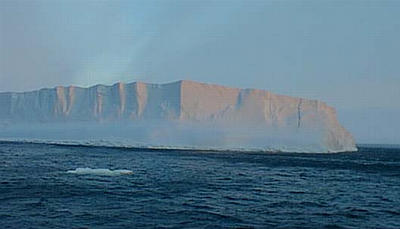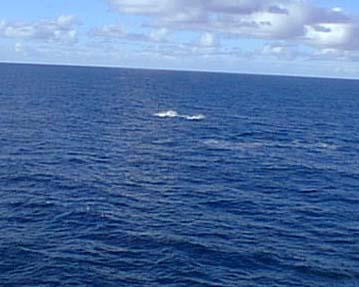28 February, 1999
February 28, 1998
Hello from the Amundsen Sea! Well, it was a slow shift today. We tried to
run a seismic line across the Amundsen Sea from the continental shelf break
to the Getz Ice Shelf. Things started out great, but before we actually
started getting any data there were problems with the seismic system. It
took all shift to finally get things working. As the night shift appeared,
we were almost in the exact same location that we were when they left 12
hours before! Thankfully, things were fixed. The night shift is running
the seismic line right now and will probably continue doing that for the
next 10 hours or so. Tomorrow, we will possibly be using the deep tow and
taking some cores . . . it all depends on how the seismic data looks. One
other thing that will happen tonight is that we will move our clocks one
more hour forward. So, we will only be four hours behind Indiana time!
Looking out the portholes today, I saw lots of seals and a few penguins.
The sea is starting to freeze on top, and a light layer of snow early this
morning made everything look white. It was impossible to distinguish
between the sea and the sky. It was really neat! I was looking for whales
today, but I didn't see any. So far, I have only seen two different types
of whales -- killer whales and minke whales. Yesterday's question was:
"What types of whales can be seen in Antarctica?" Actually, there are
several types of whales that are found in Antarctica. Remember, whales are
mammals. Even though they are adapted to live their entire lives at sea,
they must come to the surface to breathe air.
Whales can be divided into two groups: the toothed whales and the baleen
whales. Toothed whales find their prey by echo-location. Killer whales
(also known as orcas) are an example of a toothed whale. Killer whales are
actually the largest type of dolphin. They are about 31 feet long and
weigh up to 7 tons. Killer whales hunt penguins, seals, fish, and
sometimes other whales. They tend to travel in small family groups that
are called pods. Orcas can be found in all seas, but they are more
abundant in colder waters. Another toothed whale is the sperm whale.
Sperm whales have huge heads and narrow tooth-filled jaws. Only the males
venture into the polar waters of Antarctica. They are probably hunting
their favorite food: squid. They eat about a ton of food each day, and
some sperm whales have been found with giant circular scars on their head.
It turns out that these scars are sucker marks from the tentacles of the
giant squid!
Other toothed whales found in Antarctica are the southern bottlenose whale
and the southern fourtooth whale. The bottlenose whale is rarely seen, and
probably migrates north in the winter. They can stay submerged for an
hour, and eat mainly squid. The southern fourtooth whale is very similar
to the southern bottlenose whale, and it would take an expert to tell them
apart. Dolphins are considered small toothed whales. There are two
species of dolphin that can be found in the Southern Ocean. The Hourglass
dolphin is the only species found throughout the Antarctic waters. It is
less than 7 feet long, and is black and white in color. They are the most
southerly of all dolphins. The southern rightwhale dolphin sometimes
enters southern waters, but it is basically a warm-water species.
Baleen whales are much larger than toothed whales. Baleen whales eat
mostly plankton. In order to get enough to eat, they continually gulp
water and plankton into their mouths or just swim with their mouths open.
The baleen acts as a filter so that the whale can expel the water and
swallow the plankton and small fish. The baleen whales that can be found
in Antarctica include: southern right whales, blue whales, fin whales,
minke whales, and humpback whales. Southern right whales were very popular
to hunt in the 19th century. That's how they got their name . . . they
were the "right" whale to hunt. Today, there are only a few of these
whales left, but they are making a comeback.
The blue whale is the largest of all whales, and they can reach lengths of
98 feet and weigh up to 150 tons. One blue whale can eat over 4 tons of
krill each day. As winter comes to Antarctica, blue whales move into
warmer waters. Unfortunately, their numbers are also very low and they do
not seem to be increasing. There are only about 1,000 left in the entire
world. Another baleen whale is the minke whale. I've seen lots of minke
whales in Antarctica. Their average length is 8-9 feet and their average
weight is 6-8 tons -- which makes them the smallest of the baleen whales.
They are very fast swimmers, and they are commonly attracted to ships. The
minke whale population is pretty high, with perhaps 200,000 animals in the
Antarctic and half a million animals worldwide.
Whale hunting was every popular in Antarctic waters during the 19th
century. Indeed, much of the early Antarctic exploration happened because
of whaling. Today, the hunting of whales is not allowed. Antarctica is a
continent, but not a country. How can there be laws that everyone is
forced to obey? We'll look at that in tomorrow's journal. See you then!
Kim Giesting
Latitude: 73 degrees 37 minutes South
Longitude: 130 degrees 09 minutes East
Temperature: -3 degrees C
Barometer: 978.2 mb
Wind Speed: 46 knots
Wind Direction: 104 degrees (from the Southeast)
Sunrise: 23:42
Sunset: 16:00

This picture of an iceberg was taken just before sunset.

This is Captain Joe's best picture of a whale in Antarctica. This picture was not taken on our cruise.

This is Kim's best picture of a whale in Antarctica. It was taken in the Ross Sea. Can you see the spout of water?
Contact the TEA in the field at
.
If you cannot connect through your browser, copy the
TEA's e-mail address in the "To:" line of
your favorite e-mail package.
|
